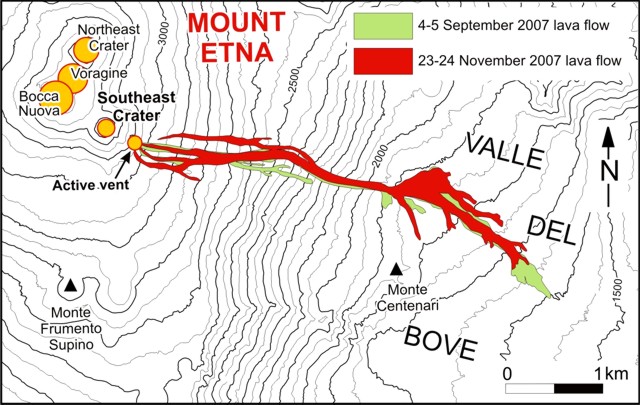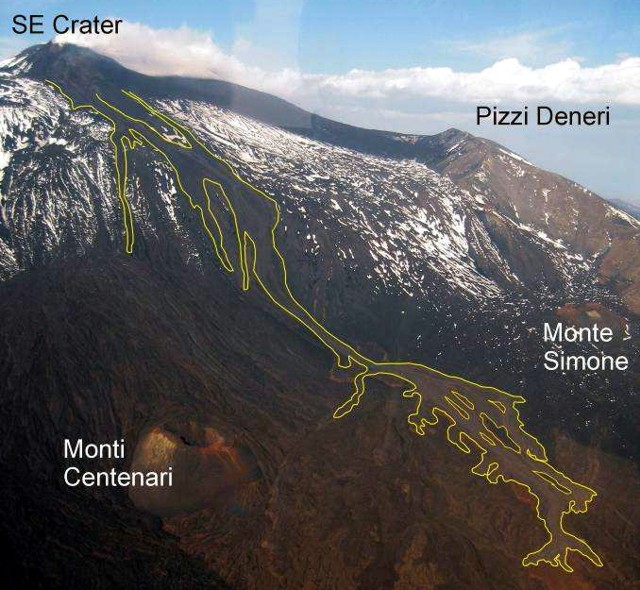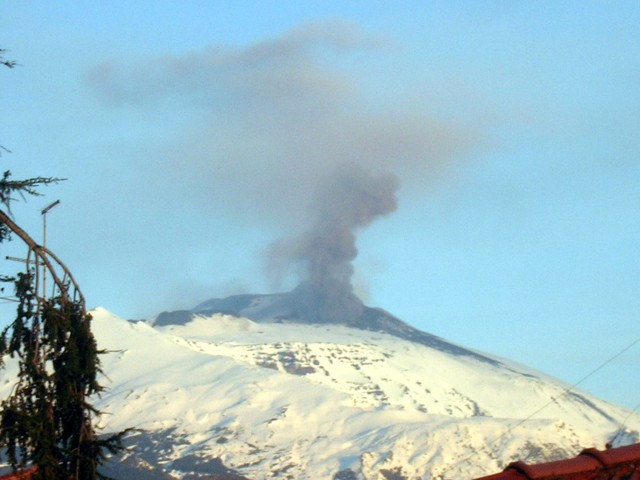Report on Etna (Italy) — January 2008
Bulletin of the Global Volcanism Network, vol. 33, no. 1 (January 2008)
Managing Editor: Richard Wunderman.
Etna (Italy) Tall sustained lava fountains, lava flows, and tephra blanket on 22-24 November 2007
Please cite this report as:
Global Volcanism Program, 2008. Report on Etna (Italy) (Wunderman, R., ed.). Bulletin of the Global Volcanism Network, 33:1. Smithsonian Institution. https://doi.org/10.5479/si.GVP.BGVN200801-211060
Etna
Italy
37.748°N, 14.999°E; summit elev. 3357 m
All times are local (unless otherwise noted)
After the 10-hour-long episode of sustained lava fountaining from the Southeast Crater (SEC) on 4-5 September 2007 (BGVN 32:09), Etna remained quiescent for about three weeks. Ash emissions then resumed from the vent on the eastern flank of the SEC cone, which had been the main focus of activity since mid-August 2007. During October, ash emissions occurred intermittently, at times with minor incandescent ejections. This activity persisted until mid-November, after which there was a week-long pause until the early morning of 22 November. That day around 0500, weak Strombolian activity and ash emission started from the vent on the E flank of the SEC and continued with increasing strength for the following 36 hours.
A series of explosions occurred at the Bocca Nuova between 1658 and 1705 on 23 November, ejecting dark gray ash plumes, and producing strong seismic signals on nearby stations. During the following hours, Strombolian explosions occurred from the SEC vent, ejecting incandescent bombs to several tens of meters high.
After 2020, the vigor increased, with bursts of bombs rising to 100 m high, accompanied by a sharp rise in tremor amplitude. By 2130, a broad, pulsating lava fountain rose from the vent. Then, 15 min later, observers saw sustained fountaining up to 600 m high. The fountains discharged from what appeared to be two closely spaced sources within the depression, often making a V-shape.
Lava spilled over the vent's rim in at least three locations (figure 129), feeding three narrow branches of lava that ran E and coalesced, before spreading down the steep W slope of the Valle del Bove. A fourth lava flow started from an area ~ 150 m NE of the active vent, where fountain-fed spatter rapidly accumulated and ultimately began to flow. This flow joined the main lava flow toward the Valle del Bove at about 2,500 m elevation.
The November lava flowed mostly on top of, or immediately adjacent to, the lava emitted during the eruption of early September 2007 (figure 129). At the base of the Valle del Bove slope, the November eruption's lava fanned out to form several minor lobes, the longest of which advanced to 1,670 m elevation, 4.2 km from the vent (figure 130; Burton and Neri, 2007).
The explosive activity fed a dense tephra plume. It blew NE and caused ash and lapilli falls as far as 80 km away in southern Calabria, (Andronico and Cristaldi, 2007). At Piano Provenzana (~ 6.5 km NNE of the summit), the deposit was about 3 cm thick. Coarse scoriae, up to 5 cm across, fell ~ 10 km NNE from the SEC (in Linguaglossa) during the first hour of the eruption. During the following hours, finer ash fell in areas adjacent Etna and to the W.
Shortly after 0300 on 24 November, the eruptive activity and volcanic tremor amplitude began to diminish gradually, and during the next 20 min the fountain height dropped from ~ 600 m to under 200 m. Subsequently, the fountaining gave way to a series of powerful explosions, which showered the entire SEC cone with meter-sized bombs. The last of these explosions occurred at 0338, and for another 45 min after this, only minor explosive ejections occurred from the vent.
During the following hours, material continued to crumble and collapse on the steep slopes around the vent, exposing incandescent rock in countless spots. By 0600, the tremor amplitude had dropped to background levels, and no further eruptive activity was noted at the vent.
For several days after the eruption, gravitational instability of the new pyroclastic deposit, which had accumulated to thicknesses of several tens of meters, especially on the N side of the vent, caused occasional slides of material, exposing the still-incandescent interior of the deposit. A particularly large collapse from the overhanging W rim of the vent at 1713 on 27 November may have been accompanied by minor explosive activity, with incandescent material rolling to the base of the SEC cone (Calvari, 2007).
Ash emissions from the same vent occurred on 10 January 2008 and again on 1-3 February (figure 131). In mid-February such emissions became more frequent; some produced plumes several hundreds of meters high.
References. Andronico, D. and Cristaldi, A., 2007, Il parossismo del 23-24 novembre 2007 al Cratere di SE: caratteristiche del deposito di caduta. Report published on-line at: http://www.ct.ingv.it/Report/RPTVETCEN20071123.pdf
Burton, M. and Neri, M., 2007, Stato attuale e osservazione dell'Etna 25 novembre 2007. Report published on-line at: http://www.ct.ingv.it/Report/WKRVGREP20071125.pdf
Calvari, S., 2007, Rapporto sull'attivit? dell'Etna del 27 novembre 2007. Report published on-line at: http://www.ct.ingv.it/Report/WKRVGREP20071127.pdf
Geological Summary. Mount Etna, towering above Catania on the island of Sicily, has one of the world's longest documented records of volcanism, dating back to 1500 BCE. Historical lava flows of basaltic composition cover much of the surface of this massive volcano, whose edifice is the highest and most voluminous in Italy. The Mongibello stratovolcano, truncated by several small calderas, was constructed during the late Pleistocene and Holocene over an older shield volcano. The most prominent morphological feature of Etna is the Valle del Bove, a 5 x 10 km caldera open to the east. Two styles of eruptive activity typically occur, sometimes simultaneously. Persistent explosive eruptions, sometimes with minor lava emissions, take place from one or more summit craters. Flank vents, typically with higher effusion rates, are less frequently active and originate from fissures that open progressively downward from near the summit (usually accompanied by Strombolian eruptions at the upper end). Cinder cones are commonly constructed over the vents of lower-flank lava flows. Lava flows extend to the foot of the volcano on all sides and have reached the sea over a broad area on the SE flank.
Information Contacts: Boris Behncke, Sonia Calvari, and Marco Neri, Istituto Nazionale di Geofisica e Vulcanologia (INGV), Sezione di Catania, Piazza Roma 2, 95123 Catania, Italy.




